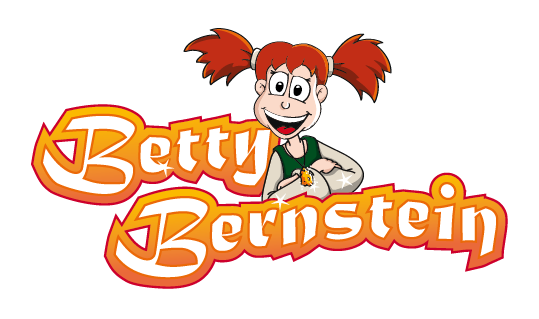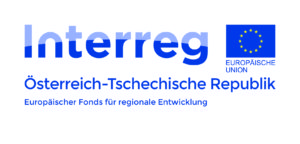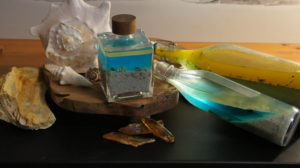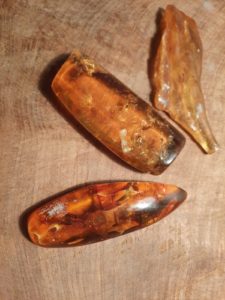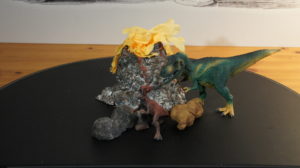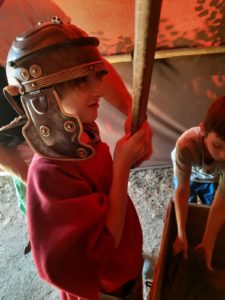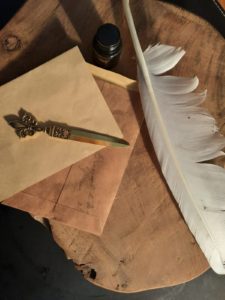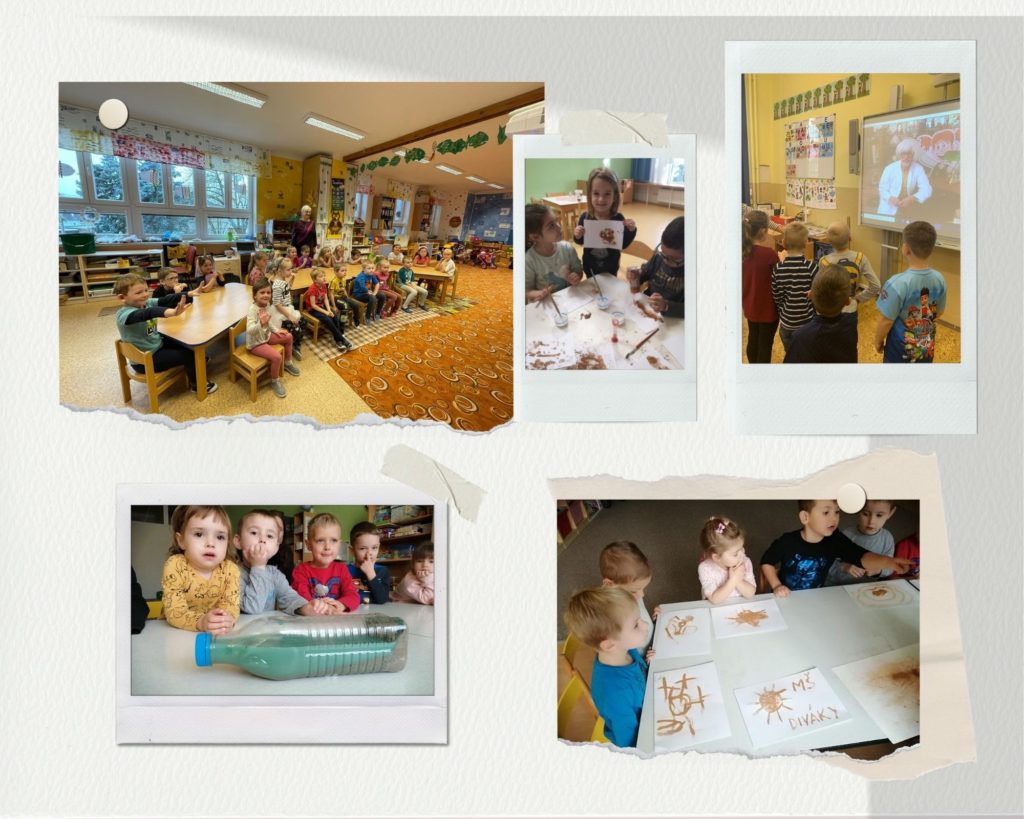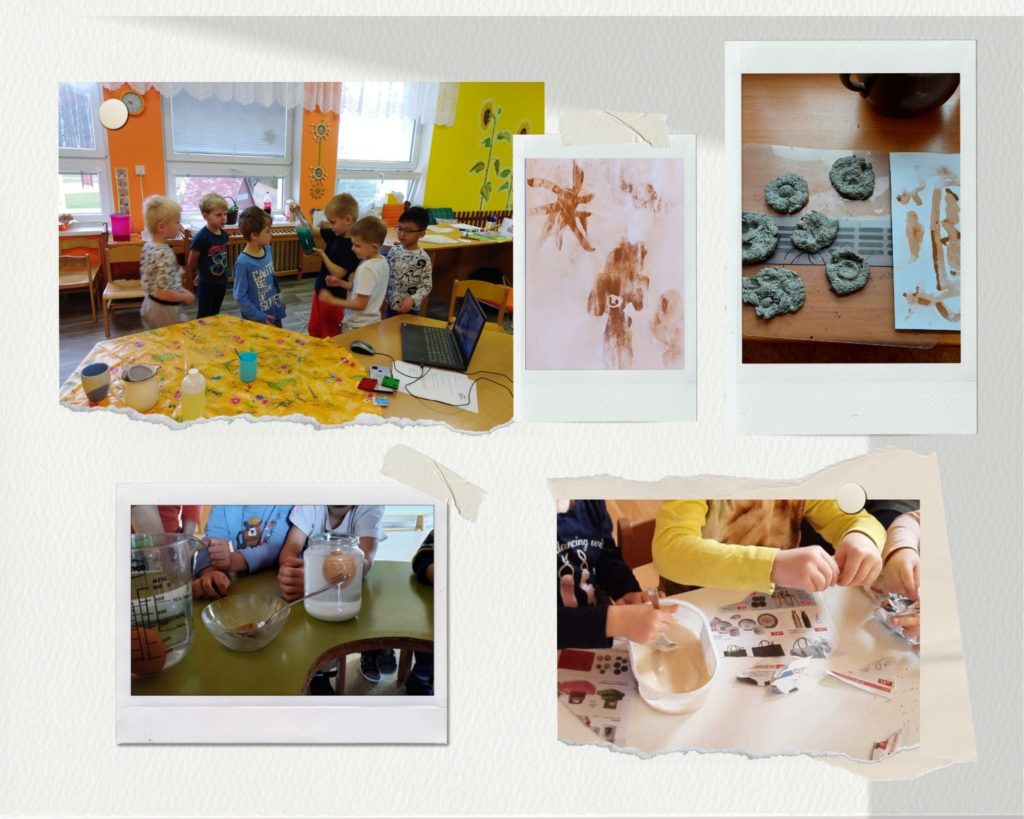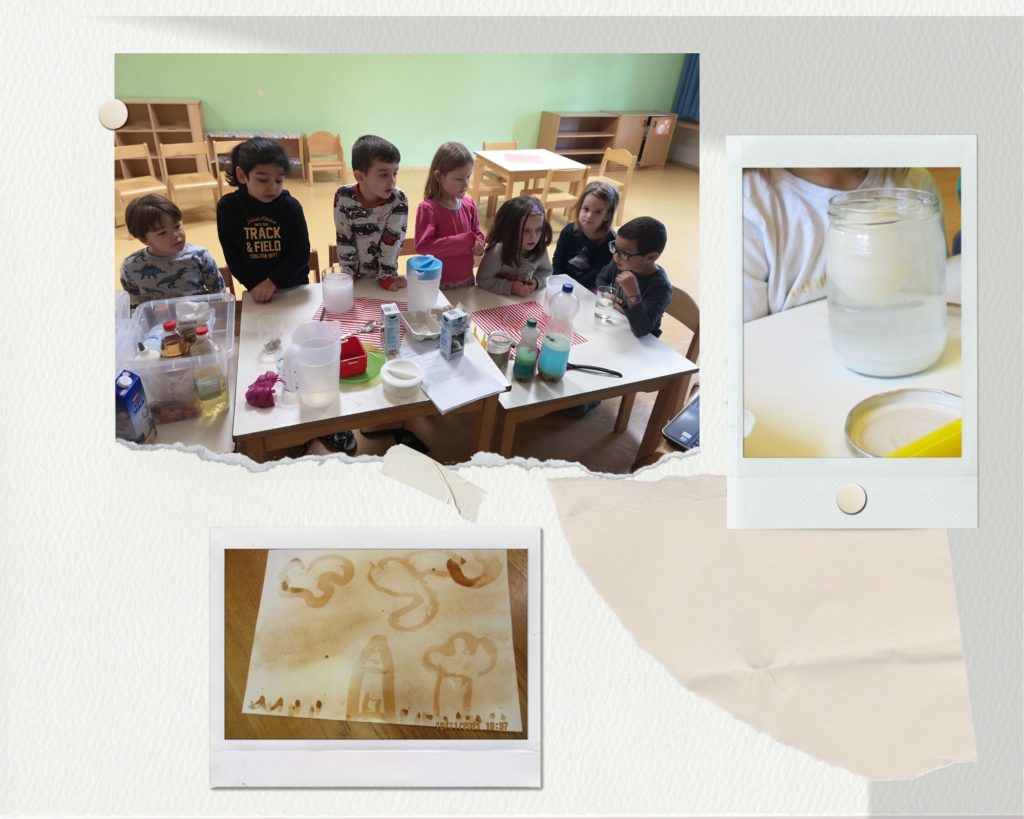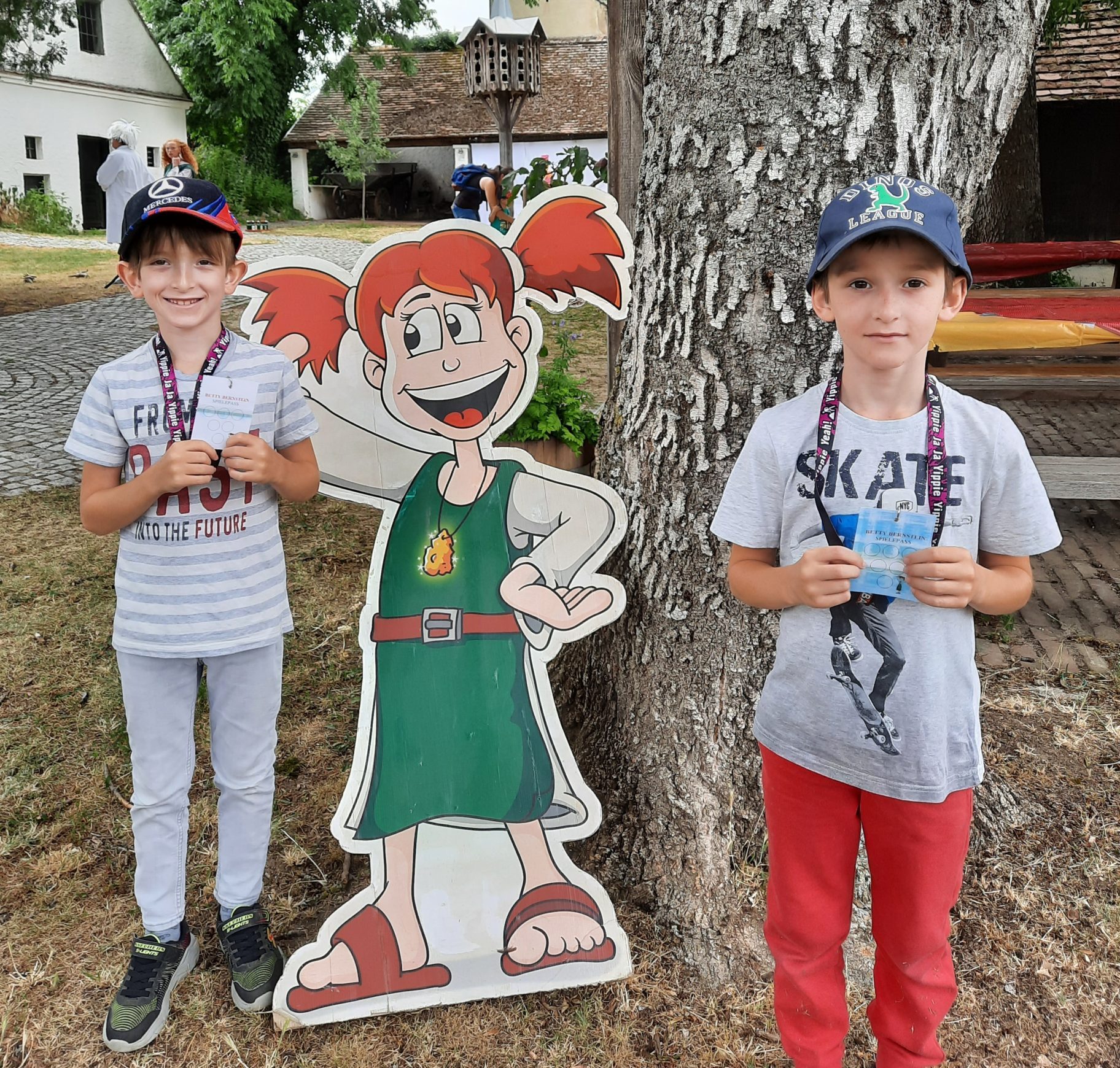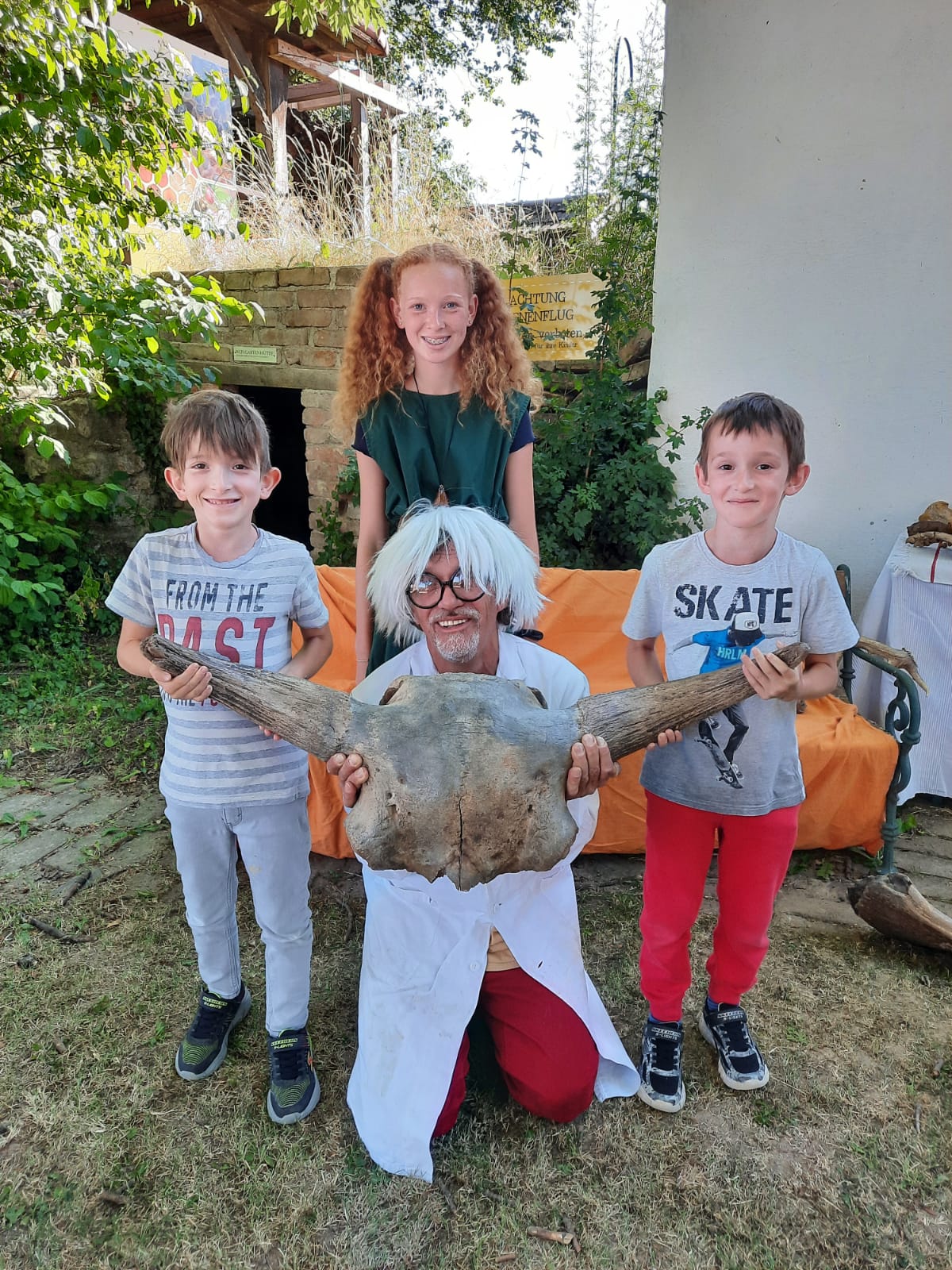
Forschertag mit Betty & Bernie
Online Forschertag mit Betty Bernstein und dem verrückten Professor
Betty Bernstein, das Mädchen mit den roten Zöpfen und dem
Zauberbernstein und der verrückte Professor Bernie Börnstein sind die
Maskottchen der Österreichischen Bernsteinstraße. Mit ihnen kann
man interessante Zeitreisen erleben und anhand spannender Experimente Geschichte hautnah erleben…
Wir besuchen die Steinzeit, spielen mit den alten Römern und schicken
geheime Nachrichten an Ritter und Könige. Wir machen unser eigenes
Urmeer und lassen Wellen entstehen. Aus Zeitungspapier basteln wir
ganz spezielle Fossilien und erforschen dabei auch den Bernstein. Was ist Bernstein und was macht
ihn so besonders? Woran erkennt man Bernstein und wie unterscheidet er sich von einfachen Steinen?
Im Rahmen des online Forschertages im November 2021 machten wir eine “Zeitreise für kleine Forscher” im digitalen Raum.
Der Forschertag wurde von der Abteilung Kindergärten des Amtes der NÖ Landesregierung im Rahmen des Programms INTERREG V-A Projekt EduSTEM (ATCZ220) organisiert.
Alle Experimente und Ergebnisse haben wir hier zusammengefasst:
Die Bernsteinstraße allgemein
Die österreichische Bernsteinstraße ist ein Verein mit ca. 30 Museen und Ausflugszielen entlang der historischen Bernsteinstraße. Sie ist eine der ältesten Nord-Süd-Handelswege in Europa und reicht von der Ostsee bis zur Adria.
Betty Bernstein, das Mädchen mit den roten Zöpfen und dem Zauberbernstein ist unser Maskottchen. Sie ist eine Reiseführerin für die ganze Familie im Weinviertel. Ob auf Burgen, Schlössern, in Thermen, Museen oder Natur-, National- und Wildparks. Mit ihr sind spannende Zeitreisen garantiert!
Bettys Freund, der verrückte Professor Bernie Börnstein, ist ein Experte für die coolsten Experimente rund um den Bernstein und erforscht mit uns die Geschichte unserer Vorfahren.
Bei Veranstaltungen und Festen entlang der Bernsteinstraße könnt ihr Betty und Bernie in voller Aktion erleben. Auf unserer Website und den social media Kanälen gibt es außerdem weitere Experimente, Ideen und Geschichten zu erkunden. Wir freuen uns auf euch!
Das Urmeer in der Flasche
Materialien:
max. 1L-Flasche mit funktionierendem Schraubverschluss (Glas oder festes Plastik und durchsichtig)
1 Trichter
1 große Tasse Sand aus der Sandkiste (möglichst sauber)
Alternative: Aquarienkies oder Dekosand aus dem Baumarkt
Wasser
Lebensmittelfarbe bereits in ganz wenig Wasser aufgelöst (blau oder grün)
Speiseöl (max. 250ml)
ein paar kleine Steine, Muscheln oder Schnecken (müssen durch den Flaschenhals passen)
Ablauf:
Die leere Flasche, den Trichter und alle Zutaten bitte bereitstellen. Dieses Experiment wird am besten von den Pädagogen selbst durchgeführt. Kinder können nach Möglichkeit beim Einfüllen der Zutaten helfen.
- Sand einfüllen
- Steine, Muscheln oder Schnecken dazugeben
- Wasser einfüllen
- Lebensmittelfarbe einfüllen
- Öl zugeben
- Flasche gut verschließen
- Schütteln, Beobachten und Experimentieren
Kann Bernstein schwimmen?
Materialien:
Wasserglas (groß genug für ein Hühnerei)
ein rohes Hühnerei
wenn echter Bernstein verfügbar ist, kann dieser zusätzlich verwendet werden
Wasser
1 Packung feines Salz
Löffel
Handtuch oder Geschirrtuch zum Abtrocken
Ablauf:
- Wasserglas zu ca. 2/3 mit Wasser füllen
- rohes Ei vorsichtig hineingeben
- Ei sinkt zu Boden (schwimmt das Ei, ist es alt)
- Ei vorsichtig mit Löffel herausheben und abtrocknen
- Wiederholung mit Bernstein, falls vorhanden
- 3 große Esslöffel Salz hinzufügen und auflösen
- Testen, ob Ei bzw. Bernstein schwimmen
- Falls nicht, nochmals Salz hinzufügen
- mit der richtigen Salz-Wasser-Mischung schwimmen Ei und Bernstein
Wir machen fossile Dinokacke!
Materialien pro Kind:
Zeitungspapier (ca. 10 große Seiten pro Kind)
4 EL Wasser
4 EL Essig
4 EL Zucker
2 EL Mehl
Selbstgemachter Bastelkleber (oder gekauften)
Rezept Bastelkleber: 2 Tassen Wasser, 5 EL Essig, 2 EL Mehl, 2 EL Stärke (z.B. Kartoffelstärke) und 5 EL Zucker in einen Topf geben und auf den Herd stellen. Umrühren und Aufkochen lassen, sodass keine Klumpen entstehen. In Schraubglas abfüllen und kühl stellen. Ist 1-2 Wochen im Kühlschrank haltbar.
Ablauf:
- Zeitungspapier in kleine Stücke reißen oder schneiden (je kleiner, desto besser)
- 4 EL Wasser, 4 EL Zucker und 4 EL Essig gut vermischen
- die Flüssigkeit mit den Zeitungsschnipseln vermengen
- 1 großen Esslöffel des Bastelklebers untermengen
- Masse gut durchkneten
- bei Bedarf weiteren Bastelkleber hinzufügen, aber ACHTUNG: die Masse soll nicht zu nass werden
- 2 EL Mehl darüber streuen (bzw. nach Bedarf mehr oder weniger)
- Kneten, bis eine gute Knetmasse vorhanden ist
Die Masse ist ca. eine Woche im Kühlschrank haltbar, wenn man sie in Folie einwickelt oder in ein verschließbares Gefäß gibt.
Am Forschertag bekommt jedes Kind eine ca. Tennisballgroße Masse an Knete. Gemeinsam erstellen wir dann damit ein Fossil, das nach dem Trocknen bemalt werden kann.
Das fertige Kunstwerk bitten an einen warmen Ort zum Trocknen geben. Bei Möglichkeit, kann man es bei 50°C in das Backrohr geben.
Spielen, wie die Römer!
1 großes hohes Gefäß (z.B. ein Eimer)
pro Kind mind. 5 Walnüsse, Haselnüsse oder Kastanien
Ablauf:
- Wir stellen ca. 3 Schritte entfernt einen Eimer auf den Boden
- Jedes Kind darf nach der Reihe versuchen die Nuss oder Kastanie in den Eimer zu schießen
- Ist das Ziel zu leicht, gehen wir weiter weg. Ist es zu schwer, dürfen wir näherkommen.
Ziel ist es, alle Nüsse im Eimer zu versenken.
Weitere Spielmöglichkeiten:
Jedes Kind erhält 5 Walnüsse oder Kastanien. Dann sucht man eine schräge Fläche oder stellt ein Brett schräg auf. Jedes Kind darf je Runde eine Nuss von oben nach unten rollen lassen. Trifft die gerollte Nuss eine oder mehrere andere Nüsse, dürfen diese eingesammelt werden. Wer am Ende die meisten Nüsse besitzt, hat gewonnen.
Die Spiele machen natürlich im Freien am meisten Spaß!
Geheime Nachrichten aus unsichtbarer Tinte
ein wenig (1- 2cl) Milch pro Kind
Papier zum Bemalen (weiß oder bunt, A4 oder kleiner)
Pinsel (oder Wattestäbchen)
gemahlenen Zimt (ca. 1TL pro Kind)
kleinen Löffel
evtl. eine Unterlage oder einen großen Teller zum Auffangen des Zimts
evtl. eine Sanduhr (nicht notwendig)
Ablauf:
- statt Farbe verwenden wir Milch als Tinte
- da unsere Tinte unsichtbar ist, wird das Malen eine kleine Herausforderung
- danach sollte die Tinte ein wenig trocknen, wurde zu viel verwendet, darf sie vorsichtig abgetupft werden
- mit Hilfe von Zimt, der auf das bemalte Blatt gestreut wird, wird unsere Tinte sichtbar und wir können gespannt die Kunstwerke bewundern
Für kleinere Kinder oder generell empfehlen wir, den Zimt auf einem großen Teller zu verteilen und das Blatt mit der bemalten Seite darauf zu legen. Ein bisschen hin- und herschieben und andrücken, schon ist das Bild sichtbar.

